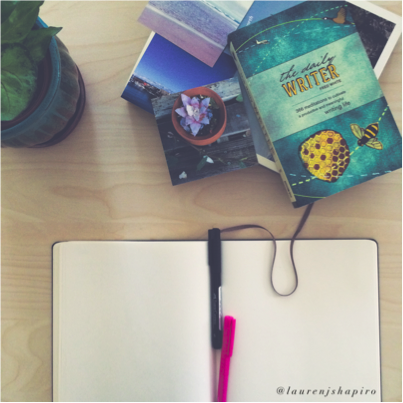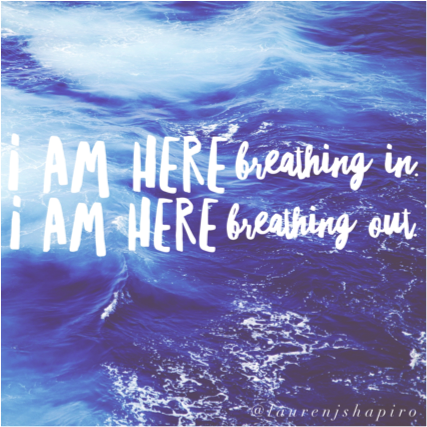When you think self-care, you may not automatically think writing. You’re not alone. But writing is actually a deceptively simple and powerful practice you can use to up your self-care game.
True, when our favorite wellness influencers talk “elf-care,” they’re typically advocating more obvious mind-body practices. Meditation. Yoga. Cooking. Gardening. Aromatherapy. Breathing. Smiling. Loving. Walking. (Screaming into a pillow works, too!) In other words, how to “ing” your way into living consciously and living well.
Personally, I’m all about it. I love talking with my holistic nutritionist about food and meal planning as self-care. I love reading online publications like MindBodyGreen, Well + Good, and On Being for lifestyle tips. I love practicing meditation as my first and last acts of the day and taking power yoga breaks to break up long days of sitting.
But, I’m a writer. I have to write, too. If I don’t, my inner “landscape” can get quite anxious and loud. Over time, I’ve figured out how to integrate writing into my daily self-care routine as another tool for healthy living.
That’s right. It’s nestled right up there in between exercising and washing my face!
Why? Because writing is a release from Busy Brain. Because writing encourages curiosity. Because writing requires focus. Because writing is portable. Because writing is free. Because writing makes space for emotions. Because writing teaches you about yourself and helps you learn. Because writing is movement. Because writing is cathartic.
But, maybe you’re not a “Writer.” Hmm …. Well, if that’s what you’re thinking, there’s good news: you don’t have to be a Writer to write.
It’s true. My one note of caution when starting to add writing into your self-care routine: don’t be too rigid.
Your writing does not have to look a certain way. It does not have to be done at the same time of day (unless you’re doing Morning Pages … see below). It doesn’t even have to sound especially “good” or even coherent. It just has to get done.
So, what makes writing a good tool for self and health anyways?
 Why Writing is a Healthy Self-Care Practice
Why Writing is a Healthy Self-Care Practice
Many healing arts and support communities encourage writing as a tool for both control and release. It seems like a contradiction. But, where do tension and anxiety often come from? Control. Now, maybe that’s just me, but I doubt it.
Writing provides an accessible way to try to control your control. Through the process of writing about whatever you are trying to control and maybe also how or why it is or isn’t working for you, you can find some release.
Now, this doesn’t have to be writing by hand, but that is what I’m talking about in this article and recommending. Because … Writing by hand uses more of your brain.
There was a time when excellent penmanship was an advanced technology! Over time, we’ve dumped handwriting in favor of faster tools like keyboards. But, to what effect?
According to the Mashable article “7 ways writing by hand can save your brain,” when you write by hand the linked regions of the brain for reading are activated. This is not the case when you type or text. So, literally when you write by hand you use more of your brain.[1]
Also, as I mentioned earlier, writing is movement. Movement involves the motor cortex of the brain. So, when you write by hand you are again literally using more of your brain, according to handwriting expert Dr. Marc Seifer.[2]
Also, some feel that writing by hand makes you more creative.
For some people, the feel of the paper induces greater creative ease. For some, it’s the slower pace. For others, the inability to easily (and perhaps obsessively!) revise like when you type frees up the inner critic to let loose the words. And still for others, there’s something about the ability to move around, to turn the page sideways, to write in the margins that encourages a wider range of creative expression.
Plus, writing is calming.
Seriously, writing by hand can be very calming. Without that revision anxiety and the inner critic chasing you, there’s more space to experience the moment … and where it takes you.
So, where will it take you? Hopefully to the page in service of your self-care. But if I haven’t convinced you yet, skim through the simple and relatively quick writing strategies below. I think one of them will call to you!
3 Ways to Add Writing into Your Self-Care Routine Today
1. Try Morning Pages
The term “Morning Pages” was coined by author and creativity expert Julia Cameron in the Artist’s Way. Morning Pages are essentially three pages of longhand writing completed first thing in the morning. (Yes, before your morning coffee. But I won’t be there to hold you to task, so use your best judgment.)
Morning Pages are not really “writing” in any formal sense. They don’t have to “make sense,” and there’s no way to do them wrong. So long as you are continually writing stream of consciousness (and by hand!) until you reach three pages, you’re getting in your self-care.
The benefit: According to Julia Cameron’s website, Moring Pages are “about anything and everything that crosses your mind–and they are for your eyes only. Morning pages provoke, clarify, comfort, cajole, prioritize and synchronize the day at hand. Do not over-think Morning Pages: just put three pages of anything on the page…and then do three more pages tomorrow.”[3]
2. Try journaling.
Journaling has kind of caught a bum rap for being “too touchy feely.” Don’t let that dissuade you. There are many different ways to approach journal writing.
So, what is it, really? Journaling is a practice and “a place where you don’t have to be anything other than exactly who you are,” according to writer and journaling expert Susannah Conway.[4]
All it requires is paper and a writing implement. You can use an actual journal book or loose leaf pages. You can use a colored pen, pencil, or even a marker if that makes the process easier. There are no rules unless you choose to set them. All that matters is that you are consistent and that the “self-caring” gets done.
Some people prefer to journal at the same time every day, like before bed. Some prefer to set a time limit. And some prefer to follow a formal prompt, like one from this list of 119 journal prompts.
While journaling is not quite as stream of consciousness as Morning Pages, you don’t have to be super rigid about it either. Pick a strategy that works for you (I personally like using a prompt), and stick with it.
The benefit: Journaling, according to Conway, provides “A place that offers solace and inspiration, possibility and retreat. Where you can gather the things you love and let your imagination take flight. A sacred place that’s 100% completely yours.”[5] Need I say more?
 3. Try writing as meditation.
3. Try writing as meditation.
There are many different philosophies for how to meditate and even why someone should meditate. While extremely interesting and nuanced, any formal approach to, or philosophy of meditation is outside the scope of this post.
Here, when I say, “meditation,” I simply mean the practice of doing meditative acts or actions.
“Meditative” acts are, generally speaking, focused concentration with intentional awareness or curiosity.
For example, if you were going to sit for meditation (i.e., sit on a cushion with back straight and eyes closed), “all” you might do is think “I am here breathing in” with every inhale and “I am here breathing out” with every exhale for a set amount of time.
That relatively simple practice of taking a meditative action (breathing + cultivating awareness about the present moment) explores who and how you are now. And it takes focus, which can be very soothing and calming (if you let it … and in time/with practice).
I believe the same applies to writing. I’ve found the technique of repeatedly writing the same statement over and over again can help soothe, calm, and even tame Busy Brain.
For example, try writing a few simple words like, “I am here now breathing,” or, “In a few days, everything will feel different,” over and over for five-ish minutes. Concentrate on the words. Repeat them in your mind as you write them. Stay present. Don’t let your mind wander or your penmanship slouch. Write with focus and intention. Then notice how you feel. Don’t think too hard about it. Just ask yourself, “How do I feel?”, and make a mental note of the first few words that come to mind. (What other phrases can you try with this technique? Leave a comment below.)
The benefit: Writer and meditation teacher Jane Brunette sums it up: “Writing can be a powerful meditation practice, helping us to integrate our active mind with the mind of meditation. By using it as a process of inquiry, it can help us track our progress in loosening attachments and habitual states of mind even as it sharpens our ability to attend to the present moment.”[6]
One Last Thing to Remember About Writing for Self-Care
Remember, writing for self-care may not be “fun” in a traditional sense of the word. But it doesn’t have to be forced or painful either. It’s natural to feel some resistance before or during the practice. I think some of that is about trying something new; some of that is about the BIG commitment of permanently putting words on paper (LOL!); and some of that is because writing is sort of intimate and vulnerable no matter if you’re a Writer or a writer.
So, I would encourage you to approach writing for self-care with an attitude of curiosity. That is all. Don’t think too hard. Don’t try to make yourself feel. Just be consistent. Get the work done.
After all, this type of writing is about the expression, about finding a home for your thoughts and feelings so you don’t have to carry them around all day if you don’t want to.
If you choose to go back and read the words later, you may discover something interesting or important about who you are in this day. But chin up (heart open!), you don’t have to read the words ever again for the benefits to take hold.
Happy writing. Let me know how it goes in the comments below.
This article is for informational purposes only. It is not intended to treat, diagnose, cure, or prevent disease. This article has not been reviewed by the FDA. Always consult with your primary care physician or naturopathic doctor before making any significant changes to your health and wellness routine.
Disclosure of Material Connection: I am the Dean of English, Communications Manager, and Press Coordinator for American College of Healthcare Sciences, the Institution that publishes this blog. However, all opinions are my own. This blog may contain affiliate links. I am disclosing this in accordance with the Federal Trade Commission’s 16 CFR, Part 255: “Guides Concerning the Use of Endorsements and Testimonials in Advertising.”
References
[1] Desta, Y. (2015). 7 ways writing by hand can save your brain. Mashable. Retrieved from http://mashable.com/2015/01/19/handwriting-brain-benefits/#t_I9UR9aoEqF
[2] Ibid.
[3] Cameron, J. (n.d.). Julia Cameron live | the Artist’s Way. Retrieved from http://juliacameronlive.com/basic-tools/morning-pages/
[4] http://www.susannahconway.com/e-courses/journal-your-life/
[5] Ibid.
[6] Brunette, J. (2013, December 8). How to Use Writing as a Meditation Practice. The Huffington Post. Retrieved from http://www.huffingtonpost.com/jane-brunette/writing-meditation_b_4035166.html



